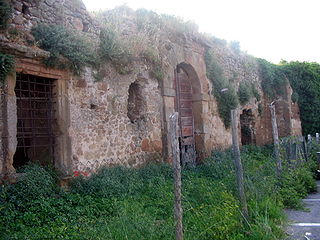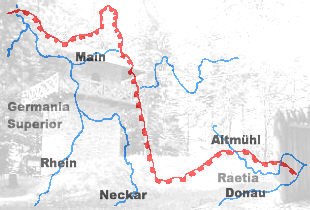 W
WRoman military borders and fortifications were part of a grand strategy of territorial defense in the Roman Empire, although this is a matter of debate. By the early 2nd century, the Roman Empire had reached the peak of its territorial expansion and rather than constantly expanding their borders as earlier in the Empire and Republic, the Romans solidified their position by fortifying their strategic position with a series of fortifications and established lines of defense. Historian Adrian Goldsworthy argues that the Romans had reached the natural limits which their military traditions afforded them conquest over and that beyond the borders of the early-to-mid Empire lay peoples whose military traditions made them militarily unconquerable, despite many Roman battle victories. In particular, Goldsworthy argues that the cavalry-based warfare of the Parthians, Sarmatians and Persians presented a major challenge to the expansion of Rome's infantry-based armies.
 W
WAn agger is an ancient Roman embankment or rampart, or any artificial elevation. It is a Latin word.
 W
WA burgus or turris ("tower") is a small, tower-like fort of the Late Antiquity, which was sometimes protected by an outwork and surrounding ditches. Darvill defines it as "a small fortified position or watch-tower usually controlling a main routeway."
 W
WA caltrop is an area denial weapon made up of two or more sharp nails or spines arranged in such a manner that one of them always points upward from a stable base. Historically, caltrops were part of defences that served to slow the advance of troops, especially horses, chariots, and war elephants, and were particularly effective against the soft feet of camels. In modern times, caltrops are effective when used against wheeled vehicles with pneumatic tires.
 W
WA castellum in Latin is usually:a small Roman fortlet or tower, a diminutive of castrum, often used as a watchtower or signal station like on Hadrian's Wall. It should be distinguished from a burgus, which was a later Latin term that was used particularly in the Germanic provinces. a distribution, header and settling tank in a Roman aqueduct or it:castellum aquae.
 W
WIn the Roman Republic and the Roman Empire, the Latin word castrum was a building, or plot of land, used as a fortified military camp. In English, the terms 'Roman fort', 'Roman camp' and 'Roman fortress' are commonly used for castrum. However, scholastic convention tends toward the use of the words 'fort', 'camp', 'marching camp' and 'fortress' as a translation of castrum.
 W
WThe castra of ancient Rome represent the complex of camps that housed the various military corps located in the city of Rome.
 W
WCastra Praetoria were the ancient barracks (castra) of the Praetorian Guard of Imperial Rome.
 W
WDerventio, sometimes described as Derventio Brigantium in order to distinguish it from other places called Derventio, was a Roman fort and settlement located beneath the modern town of Malton in North Yorkshire, England. The fort is positioned 18 miles north-east of Eboracum on the River Derwent.
 W
WHıdırlık Tower is a landmark tower of tawny stone in Antalya, Turkey, where Kaleiçi meets Karaalioglu Park. It is believed that the ruling Roman Empire built it in the second century CE on a square plan. In the same century, it was turned into circular tower.
 W
WThe Imperial Limes Commission or RLK, was set up to work out the route of the Upper Germanic-Rhaetian Limes, the Roman frontier north of the Alps, and the location of its associated forts at the time of the Roman Empire. It was the first institution to engage in a cross-border, historical project after German Unification in 1871.
 W
WLimes is a modern term used primarily for the Germanic border defence or delimiting system of Ancient Rome marking the borders of the Roman Empire, but it was not used by the Romans for this purpose. The term has been extended to refer to the frontier defences in other parts of the empire, such as in the east and in Africa.